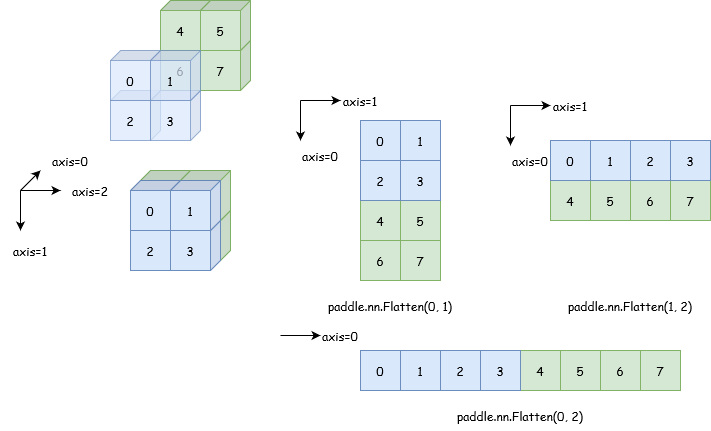flatten
根据给定的 start_axis 和 stop_axis 将连续的维度展平。
备注
在动态图模式下,输出 Tensor 将与输入 Tensor 共享数据,并且没有 Tensor 数据拷贝的过程。如果不希望输入与输出共享数据,请使用 Tensor.clone,例如 flatten_clone_x = x.flatten().clone() 。
例如:
Case 1:
给定
X.shape = (3, 100, 100, 4)
且
start_axis = 1
stop_axis = 2
得到:
Out.shape = (3, 100 * 100, 4)
Case 2:
给定
X.shape = (3, 100, 100, 4)
且
start_axis = 0
stop_axis = -1
得到:
Out.shape = (3 * 100 * 100 * 4)
下图展示了一个[2, 2, 2]的 Tensor 在经过不同参数的 Flatten 后的形状,数据依次为 0 到 7。
可以看到,在通过不同参数的 Flatten 后,Tensor 在 start_axis 与 stop_axis 维度间按照升序顺序重新排列元素。

备注
别名支持: 参数名 input 可替代 x 、 start_dim 可替代 start_axis 和 ehd_dim 可替代 stop_axis。 如 input=tensor_x 等价于 x=tensor_x, start_dim=1 等价于 start_axis=1 和 ehd_dim=1 等价于 stop_axis=1。
参数
x (Tensor) - 多维 Tensor,数据类型可以为 float16、float32、float64、int8、int32 或 int64。 别名:
inputstart_axis (int) - flatten 展开的起始维度。 别名:
start_dimstop_axis (int) - flatten 展开的结束维度。 别名:
end_dimname (str,可选) - 具体用法请参见 api_guide_Name,一般无需设置,默认值为 None。
返回
Tensor,一个 Tensor,它包含输入 Tensor 的数据,但维度发生变化。输入将按照给定的 start_axis 和 stop_axis 展开。数据类型与输入 x 相同。
代码示例
>>> import paddle
>>> image_shape=(2, 3, 4, 4)
>>> x = paddle.arange(end=image_shape[0] * image_shape[1] * image_shape[2] * image_shape[3])
>>> img = paddle.reshape(x, image_shape)
>>> out = paddle.flatten(img, start_axis=1, stop_axis=2)
>>> print(out.shape)
[2, 12, 4]
>>> # out shares data with img in dygraph mode
>>> img[0, 0, 0, 0] = -1
>>> print(out[0, 0, 0])
Tensor(shape=[], dtype=int64, place=Place(cpu), stop_gradient=True,
-1)